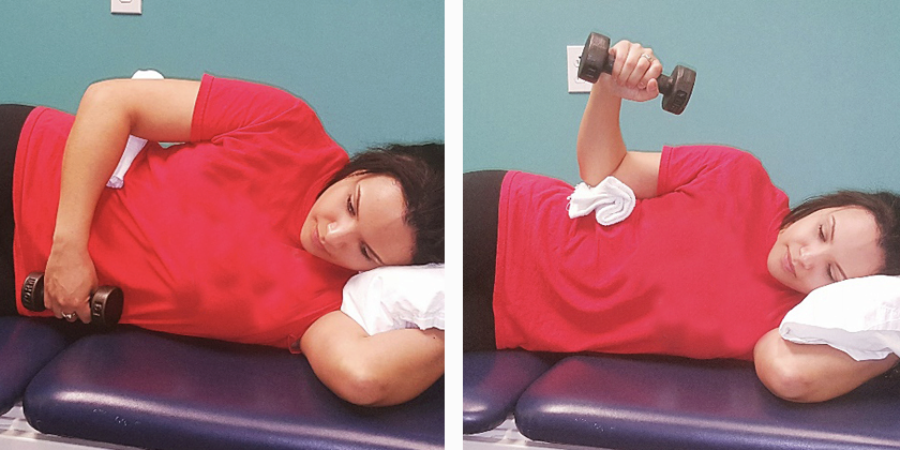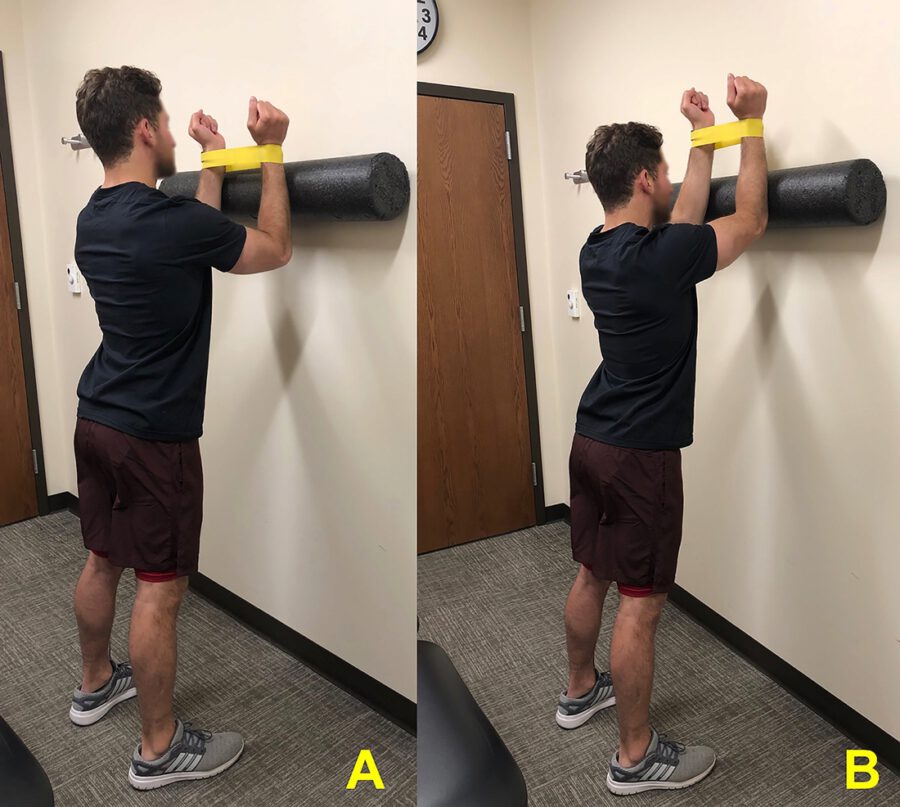Reduce Neck Pain Using Shoulder Stabilization Exercises
Have you ever had neck pain that usually comes and goes?
A pain that keeps on coming back no matter what you do?
In today’s modern time, we heavily rely on sitting in front of a computer or using our mobile devices.
Unfortunately, these activities require prolonged fixation of our head in a particular position, and often, we are prone to be in inefficient positions that are not healthy for your neck (cervical spine) and your overall posture.
No wonder that every year, the cases of neck pain are increasing.
The muscles in your cervical spine receive a lot of stress from supporting and allowing your head movements every day, but sometimes your neck pain may be caused by whole other factors.
We tend to utilize bad habits every day that negatively affects our spinal health and posture in the long run.
Your body is a chain of interconnecting structures that affect each other.
Therefore, any weakness, imbalance, or injury to a part of your body will have a cascading impact on other structures.
For instance, inefficient contraction and injuries to the rotator cuff muscles may indirectly affect the mechanics of your neck, causing you pain and discomfort.
This article will show you different shoulder exercises to help you build stable shoulders and decrease neck pain.
The rotator cuff is a group muscle that stabilizes the shoulder joint and allows movement of the arms, it includes
- Supraspinatus
- Subscapularis
- Infraspinatus
- Teres minor
Injuries and muscle imbalance with the rotator cuff will result in your muscles having a hard time stabilizing the shoulder during lifting or rotation movements.
This may cause over-activation and compensation of other shoulder stabilizers connected to your neck (cervical spine), such as trapezius muscle and elevator scapulae muscle.
This produces an extreme amount of stress on the neck muscles.
Strains and other issues around the shoulder can result to extreme amount of stress on the neck which can alter the natural mechanics of other structures around it.
Target muscles
- Supraspinatus
- Dumbbells
Full can exercise is great in effectively isolating the supraspinatus muscle during the movement. This exercise helps correct muscle imbalances and develop good posture by promoting healthy movements of the shoulder blades.
Be sure to squeeze your butt when lifting it off the ground.
- Step 1: Stand straight with shoulder-width apart. Keep your arms on the side. Use light weights as a starting point. Place your hands in neutral position.
- Step 2: Raise your arms about 30 degrees from sideways (scaption) until you reach shoulder level. Hold the position for at least 2 seconds.
- Step 3: Slowly move back down to the starting position and do it again for 10 to 15 repetitions for 3 sets.
Be sure to keep your shoulder blades (scapula) back and pin down (retracted) throughout the movement to increase the joint space and allow efficient contraction of the supraspinatus muscle.
Full can exercise promotes healthy movement patterns while building up the strength of the rotator cuff muscles.
Target muscles
- Infraspinatus
- Teres minor
- Dumbbell
Side lying external rotation exercises elicit the strong activation of both the infraspinatus and teres minor muscles.
Unfortunately, these muscles are often overlooked when training, resulting to muscle imbalance and injury.
- Step 1: Lie on your side. Place a towel roll in between your shoulder and rib cage. Pull the shoulder blades back and down (retraction). Keep your arm parallel to the floor and keep your elbow pinned against the towel.
- Step 2: Slowly move your shoulders outward and back (external rotation) by moving your arm up towards the ceiling.
- Step 3: Slowly move back down to the starting position and do it again for 10 to 15 repetitions for 3 sets. Do it on the other side.
Keep your shoulder blades retracted throughout the movement. Do not let your elbow drift away from the towel.
Side lying external rotation strengthens the external rotators. These muscles are essential in providing stability on the shoulder and promoting good posture
Target muscles
- Serratus anterior
- No equipment
Scapular push up promotes mobility and proper functioning of the shoulder blades (scapula).
- Step 1: Start in a kneeling position with your hands directly underneath your shoulders. Keep your body in a straight line with your head relax and aligned with the spine.
- Step 2: Engage your core muscles, slowly move your shoulder blades back as if you are squeezing a ball behind your back. Do not lower your chest to the floor. Hold for 3 to 5 seconds.
- Step 3: Slowly move back to the starting position and do it again for 10 to 15 repetitions for 3 sets.
Prioritize the quality of your movement. Do it slowly and feel the contraction around the shoulder blades.
Scapular push up is great in mobilizing the shoulder blades and activating the serratus anterior. It is a great activation exercise for your pre-workout routine.
Target muscles
- Deltoids
- Rotator cuff
- Serratus anterior
- Dumbbell
Diagonal raise trains the shoulder to develop scapular control. This exercise targets the fibers of the shoulder region since the muscles around the shoulders are diagonally oriented.
- Step 1: Stand with your feet shoulder-width apart. Place your right arm diagonally towards your left hip. Slightly bend your elbow.
- Step 2: Inhale, then exhale as you slowly raise your arms diagonally towards the right side of your body. Follow the movement of the dumbbell with your head.
- Step 3: Do this pattern for 10 to 15 repetition for 3 sets. Then do it with your left arm.
Make sure that you are not using the momentum to raise the weight up. Instead, maintain good control of the movement throughout the range.
Diagonal raise allows movement of the shoulder joint in all range of motion instead of the traditional lifting exercise. This provides functional training for your shoulder
Target muscles
- Serratus anterior
- Rotator cuff
- Foam Roller
- Resistances band (progression)
Wall roll-up is a good mobility exercise for overhead activities.
It actively engages the rotator cuff muscles while promoting movements of the shoulder blades.
- Step 1: Stand in front of a wall. Press the foam roller into the wall against your forearms. Maintain a good distance between both of your arms.
- Step 2: Roll your arms upward while maintaining the foam roller against the wall. Keep an outward pressure on your shoulders as you roll your arms to the top.
- Step 3: Slowly move back to the starting position. Do this movement for 10 to 15 repetitions for 3 sets.
Maintain the pressure upward and outward. Feel the contraction of the muscles around your shoulder blades. You can also add a resistance band on your forearms to create more tension and progress the exercise.
Wall roll up promotes stabilization of the shoulder through the effective strengthening of the serratus anterior and rotator cuff while allowing a good range of motion.
Shoulder issues can indirectly cause neck pain. Injuries, muscle imbalance, and inefficient posture can alter your body mechanics, resulting in pain and increased risk of other injuries.
Strengthening your rotator cuff muscles and other shoulder stabilizers can prevent injuries to the shoulders and decrease the stress on the muscles around your neck during activities.
It is essential to pay attention to your workout routines and make sure that you do not neglect vital muscles to keep your body in optimal health.
- Katsuura Y, Bruce J, Taylor S, Gullota L, Kim H.J (2019) Overlapping, Masquerading, and Causative Cervical Spine and Shoulder Pathology: Systematic Review
- Pateder D, Berg J, Thal R (2009) Neck and shoulder pain: differentiating cervical pathology from shoulder pathology
- Reinold M, Escamilla R, Wilk K (2009) Behind Exercises for Glenohumeral and Scapulothoracic Musculature
- Reinold M, Macrina L, Wilk K, Fleisig G, Dun S, Barrentine S, Ellerbusch M, Andrew J (2007) Electromygraphic Analysis of the Supraspinatus and Deltoid Muscles During 3 Common Rehabilitation Exercises
- Reinold M, Wilk K, Fleisig G, Zheng N, Barrentine S, Chmielewski T, Cody R, Jameson G, Andrew J (2004) Electromyographic analysis of the rotator cuff and deltoid musculature during common shoulder external rotation exercises



